Human Resource Management Report: Tarmac and Titan Cement
VerifiedAdded on 2019/12/18
|21
|5433
|99
Report
AI Summary
This report provides a comprehensive analysis of human resource management (HRM), focusing on the practices of Tarmac UK and Titan Cement UK Ltd. It begins by differentiating HRM from personnel management and highlighting HRM's role in organizational success and legal compliance. The report examines the stages of human resource planning at Tarmac, including objective analysis, inventory of resources, forecasting, and action plan formulation. It then compares the effectiveness of recruitment and selection processes between Tarmac and Titan Cement, evaluating their strengths and weaknesses. Furthermore, the report explores the link between reward systems at Tarmac and motivational theories, such as Maslow's hierarchy of needs and Herzberg's two-factor theory. It also discusses factors determining pay, job evaluation, and the relevance of reward systems in different contexts. Finally, the report addresses employee termination processes, comparing Tarmac and Titan Cement, and considers the influence of legal and regulatory frameworks on employment termination agreements, offering recommendations based on the HRM analysis.
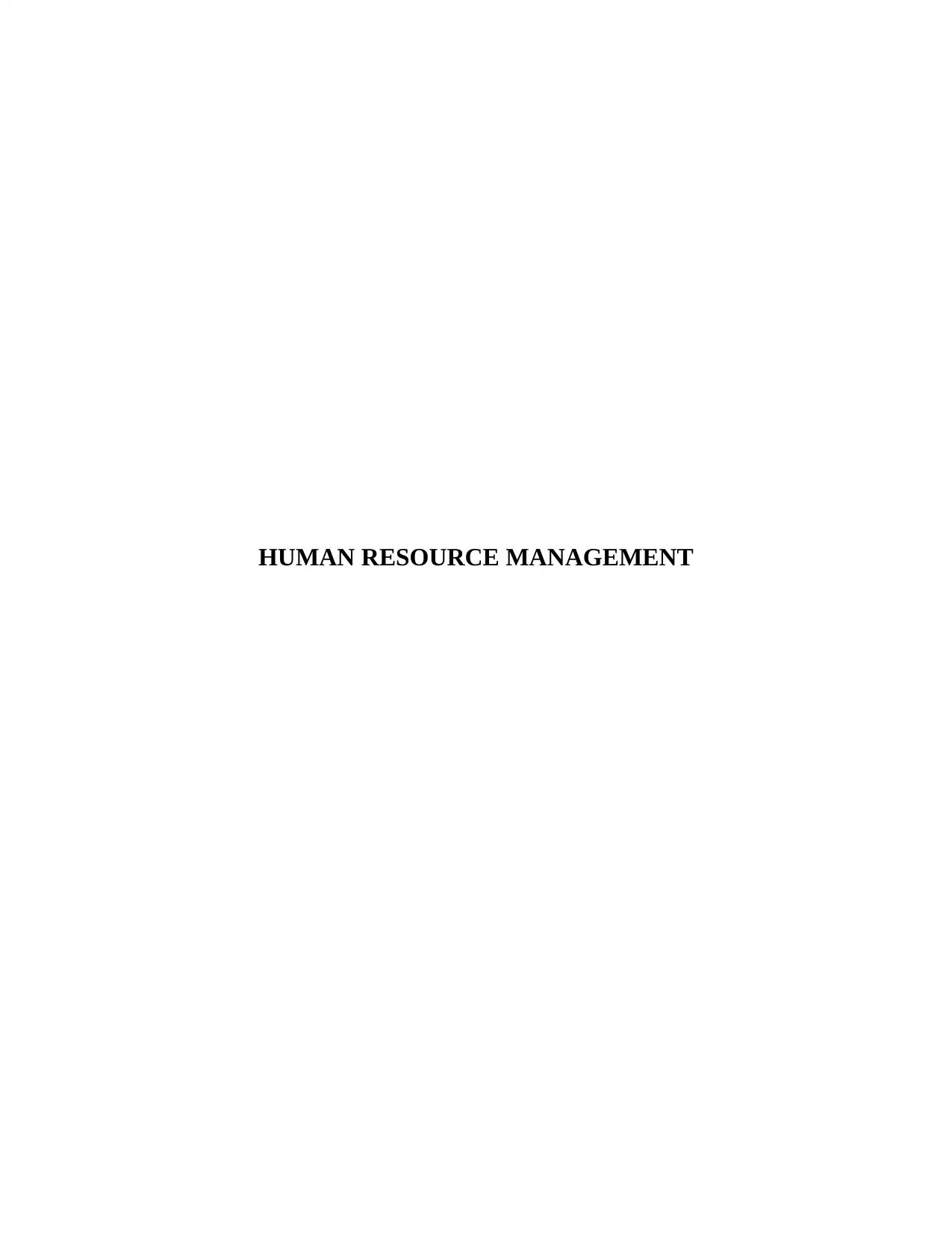
HUMAN RESOURCE MANAGEMENT
Paraphrase This Document
Need a fresh take? Get an instant paraphrase of this document with our AI Paraphraser
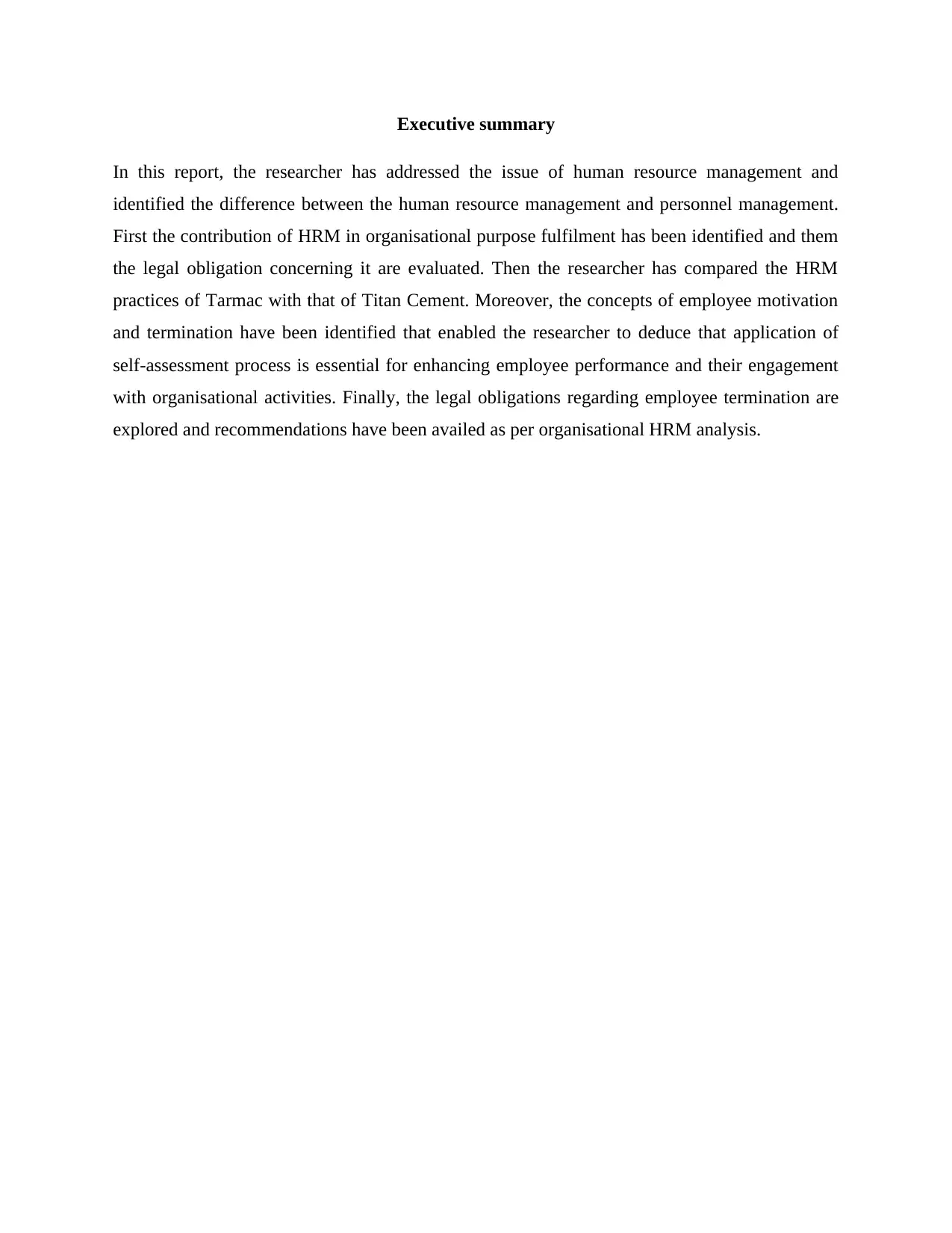
Executive summary
In this report, the researcher has addressed the issue of human resource management and
identified the difference between the human resource management and personnel management.
First the contribution of HRM in organisational purpose fulfilment has been identified and them
the legal obligation concerning it are evaluated. Then the researcher has compared the HRM
practices of Tarmac with that of Titan Cement. Moreover, the concepts of employee motivation
and termination have been identified that enabled the researcher to deduce that application of
self-assessment process is essential for enhancing employee performance and their engagement
with organisational activities. Finally, the legal obligations regarding employee termination are
explored and recommendations have been availed as per organisational HRM analysis.
In this report, the researcher has addressed the issue of human resource management and
identified the difference between the human resource management and personnel management.
First the contribution of HRM in organisational purpose fulfilment has been identified and them
the legal obligation concerning it are evaluated. Then the researcher has compared the HRM
practices of Tarmac with that of Titan Cement. Moreover, the concepts of employee motivation
and termination have been identified that enabled the researcher to deduce that application of
self-assessment process is essential for enhancing employee performance and their engagement
with organisational activities. Finally, the legal obligations regarding employee termination are
explored and recommendations have been availed as per organisational HRM analysis.
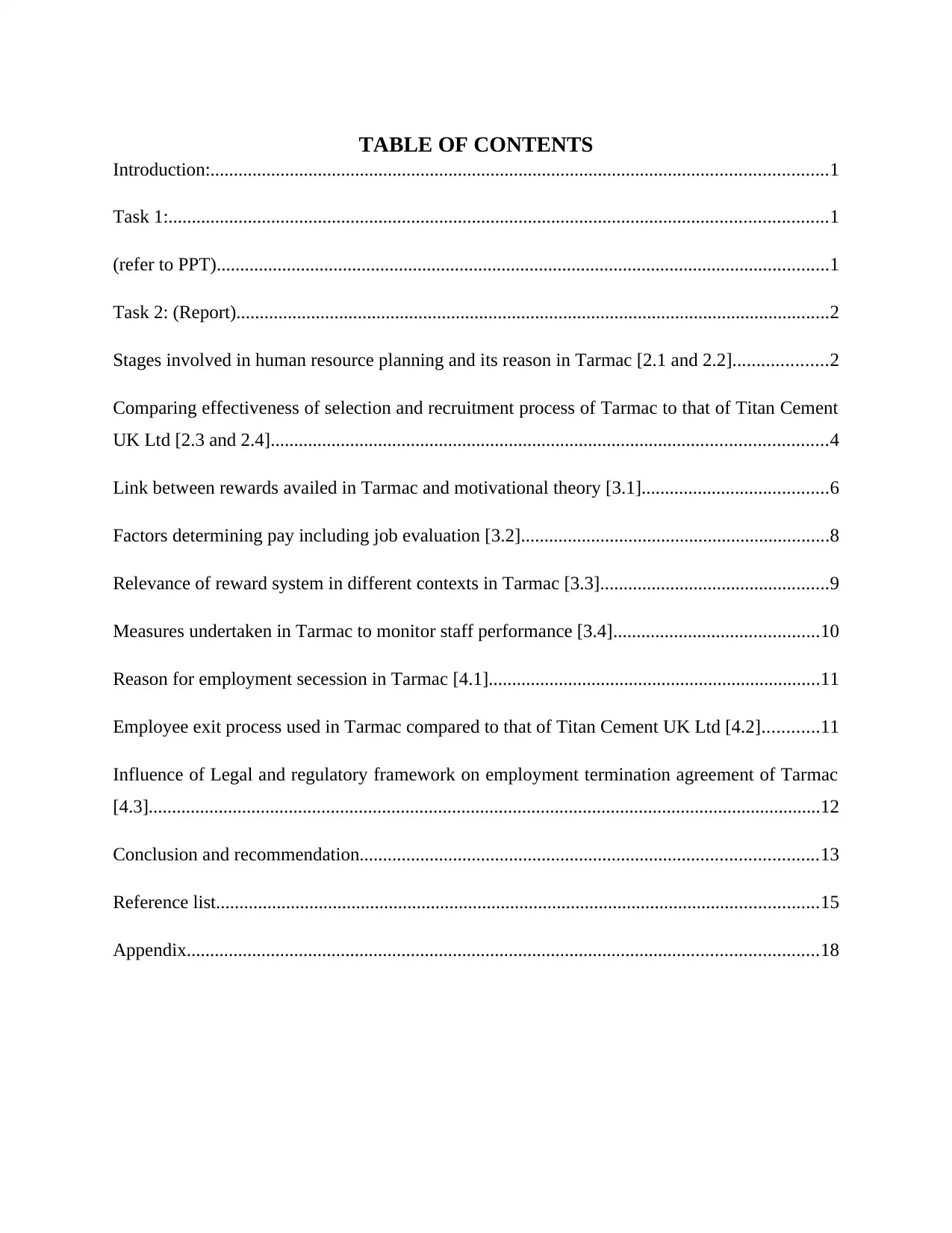
TABLE OF CONTENTS
Introduction:....................................................................................................................................1
Task 1:.............................................................................................................................................1
(refer to PPT)...................................................................................................................................1
Task 2: (Report)...............................................................................................................................2
Stages involved in human resource planning and its reason in Tarmac [2.1 and 2.2]....................2
Comparing effectiveness of selection and recruitment process of Tarmac to that of Titan Cement
UK Ltd [2.3 and 2.4].......................................................................................................................4
Link between rewards availed in Tarmac and motivational theory [3.1]........................................6
Factors determining pay including job evaluation [3.2]..................................................................8
Relevance of reward system in different contexts in Tarmac [3.3].................................................9
Measures undertaken in Tarmac to monitor staff performance [3.4]............................................10
Reason for employment secession in Tarmac [4.1].......................................................................11
Employee exit process used in Tarmac compared to that of Titan Cement UK Ltd [4.2]............11
Influence of Legal and regulatory framework on employment termination agreement of Tarmac
[4.3]................................................................................................................................................12
Conclusion and recommendation..................................................................................................13
Reference list.................................................................................................................................15
Appendix.......................................................................................................................................18
Introduction:....................................................................................................................................1
Task 1:.............................................................................................................................................1
(refer to PPT)...................................................................................................................................1
Task 2: (Report)...............................................................................................................................2
Stages involved in human resource planning and its reason in Tarmac [2.1 and 2.2]....................2
Comparing effectiveness of selection and recruitment process of Tarmac to that of Titan Cement
UK Ltd [2.3 and 2.4].......................................................................................................................4
Link between rewards availed in Tarmac and motivational theory [3.1]........................................6
Factors determining pay including job evaluation [3.2]..................................................................8
Relevance of reward system in different contexts in Tarmac [3.3].................................................9
Measures undertaken in Tarmac to monitor staff performance [3.4]............................................10
Reason for employment secession in Tarmac [4.1].......................................................................11
Employee exit process used in Tarmac compared to that of Titan Cement UK Ltd [4.2]............11
Influence of Legal and regulatory framework on employment termination agreement of Tarmac
[4.3]................................................................................................................................................12
Conclusion and recommendation..................................................................................................13
Reference list.................................................................................................................................15
Appendix.......................................................................................................................................18
⊘ This is a preview!⊘
Do you want full access?
Subscribe today to unlock all pages.

Trusted by 1+ million students worldwide
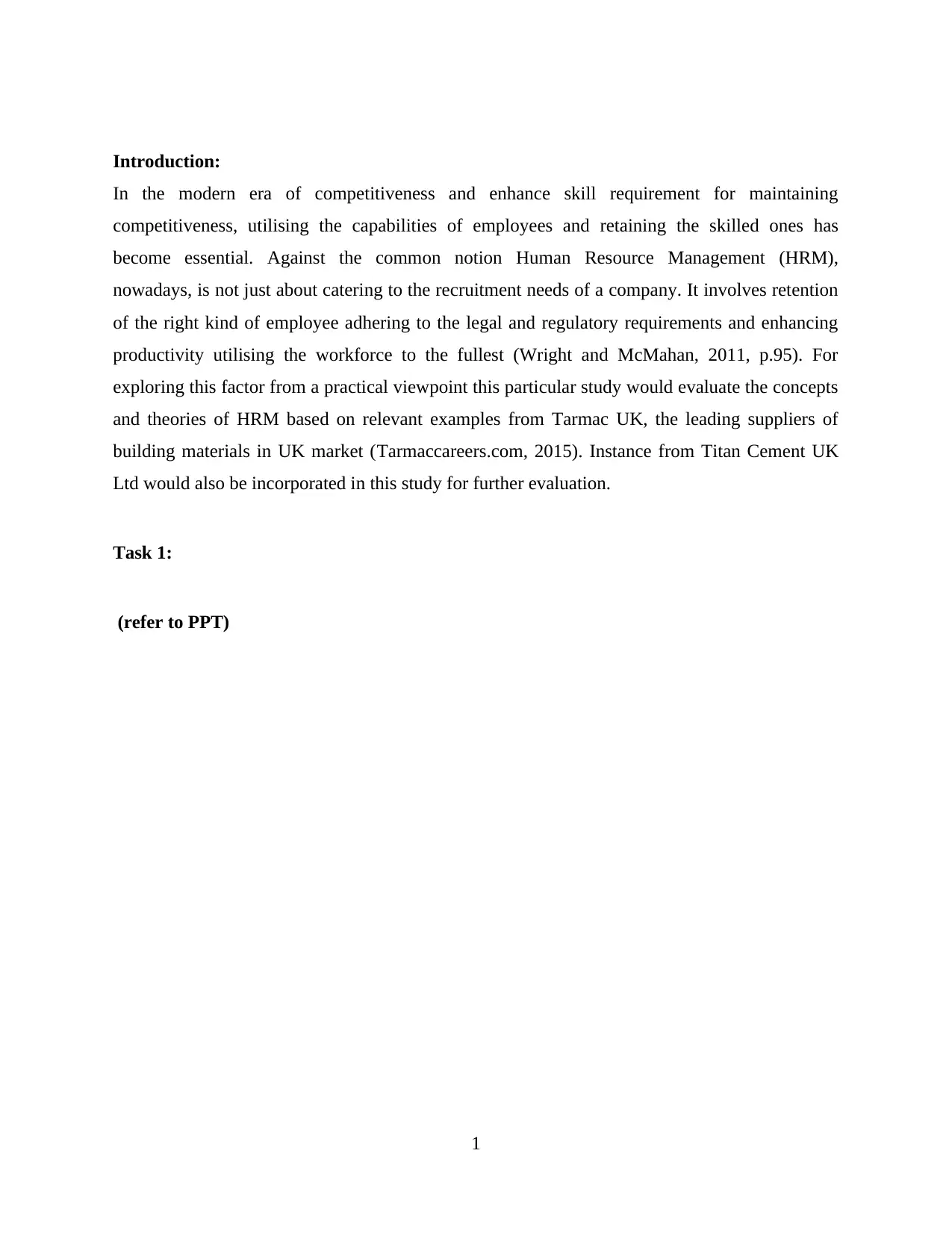
Introduction:
In the modern era of competitiveness and enhance skill requirement for maintaining
competitiveness, utilising the capabilities of employees and retaining the skilled ones has
become essential. Against the common notion Human Resource Management (HRM),
nowadays, is not just about catering to the recruitment needs of a company. It involves retention
of the right kind of employee adhering to the legal and regulatory requirements and enhancing
productivity utilising the workforce to the fullest (Wright and McMahan, 2011, p.95). For
exploring this factor from a practical viewpoint this particular study would evaluate the concepts
and theories of HRM based on relevant examples from Tarmac UK, the leading suppliers of
building materials in UK market (Tarmaccareers.com, 2015). Instance from Titan Cement UK
Ltd would also be incorporated in this study for further evaluation.
Task 1:
(refer to PPT)
1
In the modern era of competitiveness and enhance skill requirement for maintaining
competitiveness, utilising the capabilities of employees and retaining the skilled ones has
become essential. Against the common notion Human Resource Management (HRM),
nowadays, is not just about catering to the recruitment needs of a company. It involves retention
of the right kind of employee adhering to the legal and regulatory requirements and enhancing
productivity utilising the workforce to the fullest (Wright and McMahan, 2011, p.95). For
exploring this factor from a practical viewpoint this particular study would evaluate the concepts
and theories of HRM based on relevant examples from Tarmac UK, the leading suppliers of
building materials in UK market (Tarmaccareers.com, 2015). Instance from Titan Cement UK
Ltd would also be incorporated in this study for further evaluation.
Task 1:
(refer to PPT)
1
Paraphrase This Document
Need a fresh take? Get an instant paraphrase of this document with our AI Paraphraser
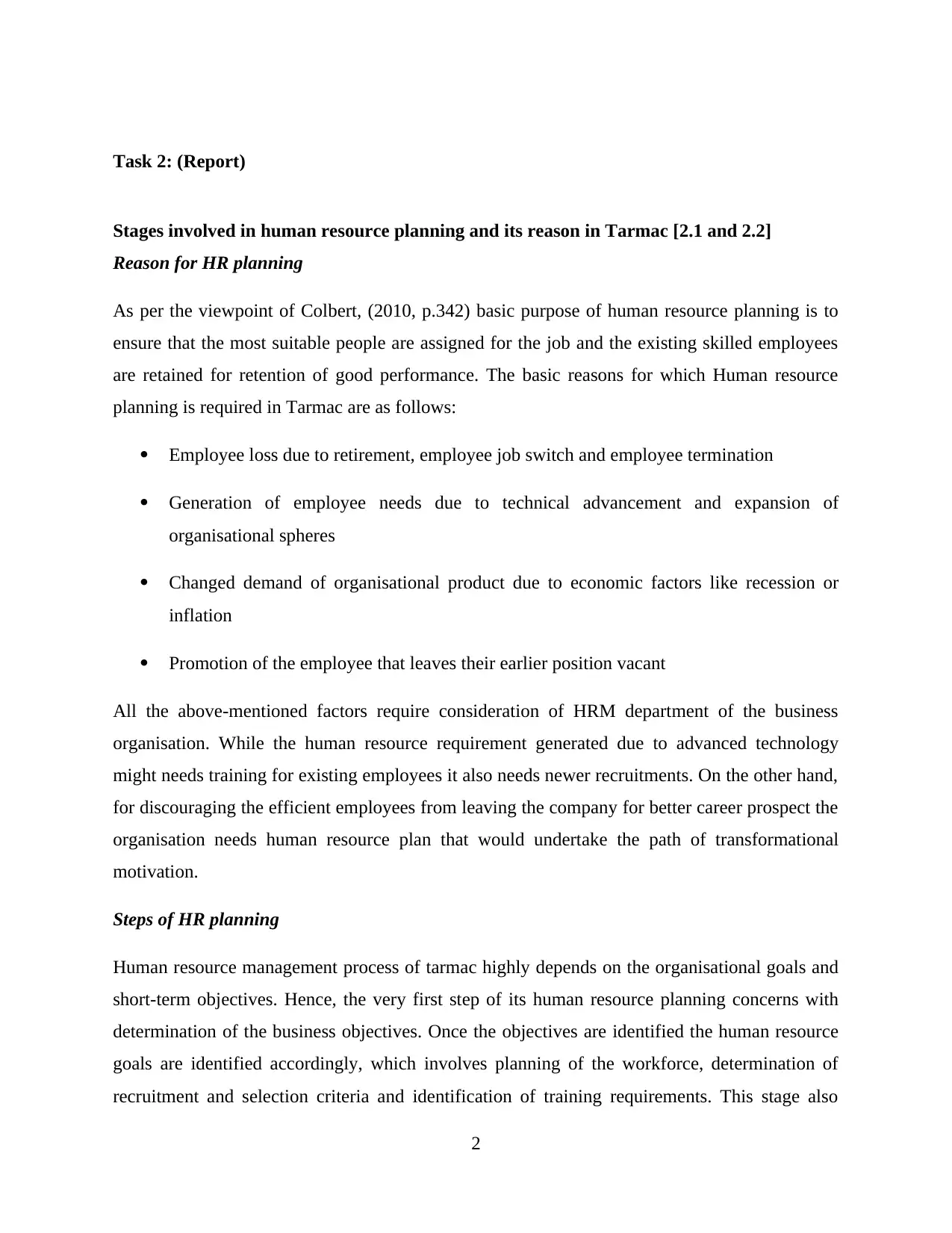
Task 2: (Report)
Stages involved in human resource planning and its reason in Tarmac [2.1 and 2.2]
Reason for HR planning
As per the viewpoint of Colbert, (2010, p.342) basic purpose of human resource planning is to
ensure that the most suitable people are assigned for the job and the existing skilled employees
are retained for retention of good performance. The basic reasons for which Human resource
planning is required in Tarmac are as follows:
Employee loss due to retirement, employee job switch and employee termination
Generation of employee needs due to technical advancement and expansion of
organisational spheres
Changed demand of organisational product due to economic factors like recession or
inflation
Promotion of the employee that leaves their earlier position vacant
All the above-mentioned factors require consideration of HRM department of the business
organisation. While the human resource requirement generated due to advanced technology
might needs training for existing employees it also needs newer recruitments. On the other hand,
for discouraging the efficient employees from leaving the company for better career prospect the
organisation needs human resource plan that would undertake the path of transformational
motivation.
Steps of HR planning
Human resource management process of tarmac highly depends on the organisational goals and
short-term objectives. Hence, the very first step of its human resource planning concerns with
determination of the business objectives. Once the objectives are identified the human resource
goals are identified accordingly, which involves planning of the workforce, determination of
recruitment and selection criteria and identification of training requirements. This stage also
2
Stages involved in human resource planning and its reason in Tarmac [2.1 and 2.2]
Reason for HR planning
As per the viewpoint of Colbert, (2010, p.342) basic purpose of human resource planning is to
ensure that the most suitable people are assigned for the job and the existing skilled employees
are retained for retention of good performance. The basic reasons for which Human resource
planning is required in Tarmac are as follows:
Employee loss due to retirement, employee job switch and employee termination
Generation of employee needs due to technical advancement and expansion of
organisational spheres
Changed demand of organisational product due to economic factors like recession or
inflation
Promotion of the employee that leaves their earlier position vacant
All the above-mentioned factors require consideration of HRM department of the business
organisation. While the human resource requirement generated due to advanced technology
might needs training for existing employees it also needs newer recruitments. On the other hand,
for discouraging the efficient employees from leaving the company for better career prospect the
organisation needs human resource plan that would undertake the path of transformational
motivation.
Steps of HR planning
Human resource management process of tarmac highly depends on the organisational goals and
short-term objectives. Hence, the very first step of its human resource planning concerns with
determination of the business objectives. Once the objectives are identified the human resource
goals are identified accordingly, which involves planning of the workforce, determination of
recruitment and selection criteria and identification of training requirements. This stage also
2
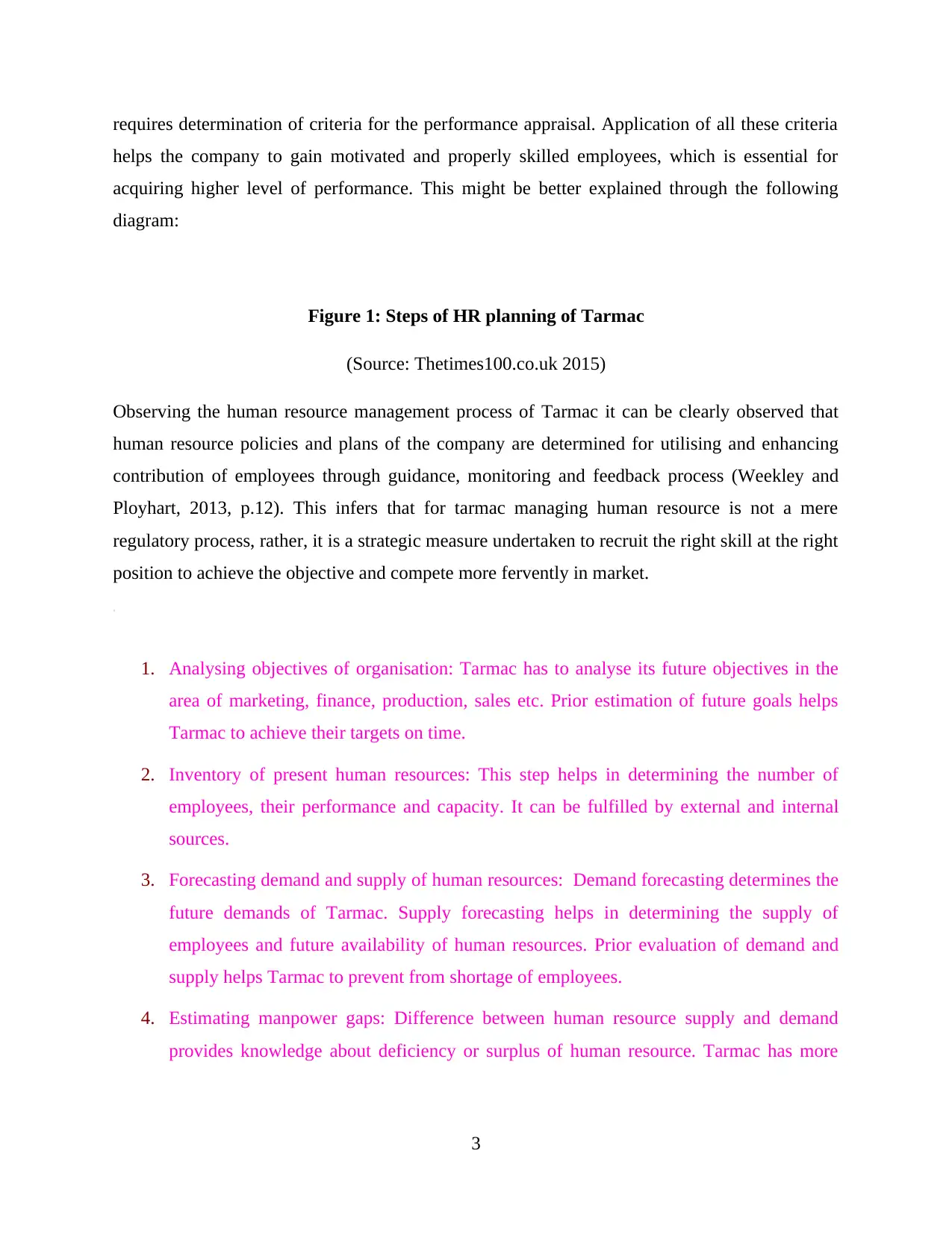
requires determination of criteria for the performance appraisal. Application of all these criteria
helps the company to gain motivated and properly skilled employees, which is essential for
acquiring higher level of performance. This might be better explained through the following
diagram:
Figure 1: Steps of HR planning of Tarmac
(Source: Thetimes100.co.uk 2015)
Observing the human resource management process of Tarmac it can be clearly observed that
human resource policies and plans of the company are determined for utilising and enhancing
contribution of employees through guidance, monitoring and feedback process (Weekley and
Ployhart, 2013, p.12). This infers that for tarmac managing human resource is not a mere
regulatory process, rather, it is a strategic measure undertaken to recruit the right skill at the right
position to achieve the objective and compete more fervently in market.
1. Analysing objectives of organisation: Tarmac has to analyse its future objectives in the
area of marketing, finance, production, sales etc. Prior estimation of future goals helps
Tarmac to achieve their targets on time.
2. Inventory of present human resources: This step helps in determining the number of
employees, their performance and capacity. It can be fulfilled by external and internal
sources.
3. Forecasting demand and supply of human resources: Demand forecasting determines the
future demands of Tarmac. Supply forecasting helps in determining the supply of
employees and future availability of human resources. Prior evaluation of demand and
supply helps Tarmac to prevent from shortage of employees.
4. Estimating manpower gaps: Difference between human resource supply and demand
provides knowledge about deficiency or surplus of human resource. Tarmac has more
3
helps the company to gain motivated and properly skilled employees, which is essential for
acquiring higher level of performance. This might be better explained through the following
diagram:
Figure 1: Steps of HR planning of Tarmac
(Source: Thetimes100.co.uk 2015)
Observing the human resource management process of Tarmac it can be clearly observed that
human resource policies and plans of the company are determined for utilising and enhancing
contribution of employees through guidance, monitoring and feedback process (Weekley and
Ployhart, 2013, p.12). This infers that for tarmac managing human resource is not a mere
regulatory process, rather, it is a strategic measure undertaken to recruit the right skill at the right
position to achieve the objective and compete more fervently in market.
1. Analysing objectives of organisation: Tarmac has to analyse its future objectives in the
area of marketing, finance, production, sales etc. Prior estimation of future goals helps
Tarmac to achieve their targets on time.
2. Inventory of present human resources: This step helps in determining the number of
employees, their performance and capacity. It can be fulfilled by external and internal
sources.
3. Forecasting demand and supply of human resources: Demand forecasting determines the
future demands of Tarmac. Supply forecasting helps in determining the supply of
employees and future availability of human resources. Prior evaluation of demand and
supply helps Tarmac to prevent from shortage of employees.
4. Estimating manpower gaps: Difference between human resource supply and demand
provides knowledge about deficiency or surplus of human resource. Tarmac has more
3
⊘ This is a preview!⊘
Do you want full access?
Subscribe today to unlock all pages.

Trusted by 1+ million students worldwide
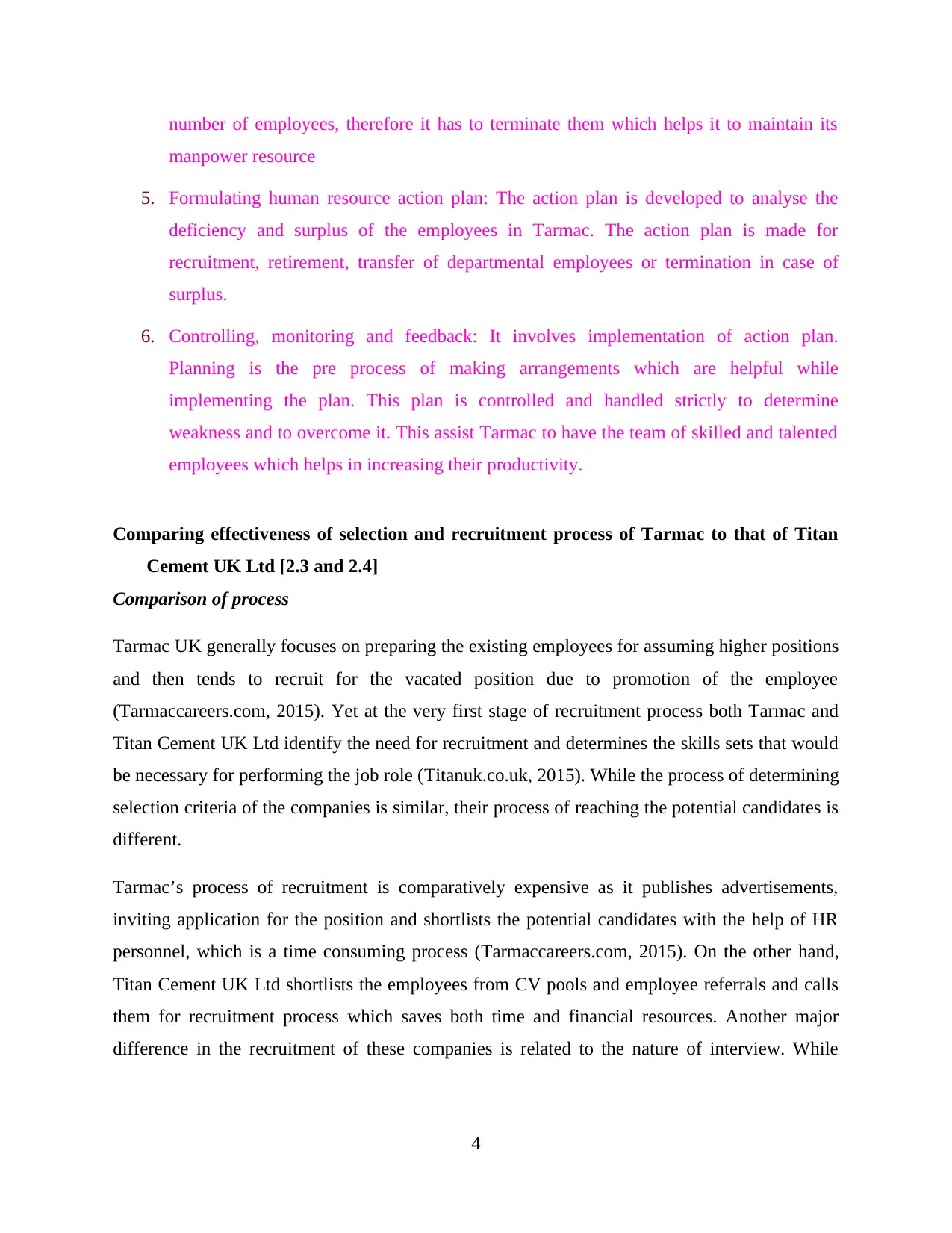
number of employees, therefore it has to terminate them which helps it to maintain its
manpower resource
5. Formulating human resource action plan: The action plan is developed to analyse the
deficiency and surplus of the employees in Tarmac. The action plan is made for
recruitment, retirement, transfer of departmental employees or termination in case of
surplus.
6. Controlling, monitoring and feedback: It involves implementation of action plan.
Planning is the pre process of making arrangements which are helpful while
implementing the plan. This plan is controlled and handled strictly to determine
weakness and to overcome it. This assist Tarmac to have the team of skilled and talented
employees which helps in increasing their productivity.
Comparing effectiveness of selection and recruitment process of Tarmac to that of Titan
Cement UK Ltd [2.3 and 2.4]
Comparison of process
Tarmac UK generally focuses on preparing the existing employees for assuming higher positions
and then tends to recruit for the vacated position due to promotion of the employee
(Tarmaccareers.com, 2015). Yet at the very first stage of recruitment process both Tarmac and
Titan Cement UK Ltd identify the need for recruitment and determines the skills sets that would
be necessary for performing the job role (Titanuk.co.uk, 2015). While the process of determining
selection criteria of the companies is similar, their process of reaching the potential candidates is
different.
Tarmac’s process of recruitment is comparatively expensive as it publishes advertisements,
inviting application for the position and shortlists the potential candidates with the help of HR
personnel, which is a time consuming process (Tarmaccareers.com, 2015). On the other hand,
Titan Cement UK Ltd shortlists the employees from CV pools and employee referrals and calls
them for recruitment process which saves both time and financial resources. Another major
difference in the recruitment of these companies is related to the nature of interview. While
4
manpower resource
5. Formulating human resource action plan: The action plan is developed to analyse the
deficiency and surplus of the employees in Tarmac. The action plan is made for
recruitment, retirement, transfer of departmental employees or termination in case of
surplus.
6. Controlling, monitoring and feedback: It involves implementation of action plan.
Planning is the pre process of making arrangements which are helpful while
implementing the plan. This plan is controlled and handled strictly to determine
weakness and to overcome it. This assist Tarmac to have the team of skilled and talented
employees which helps in increasing their productivity.
Comparing effectiveness of selection and recruitment process of Tarmac to that of Titan
Cement UK Ltd [2.3 and 2.4]
Comparison of process
Tarmac UK generally focuses on preparing the existing employees for assuming higher positions
and then tends to recruit for the vacated position due to promotion of the employee
(Tarmaccareers.com, 2015). Yet at the very first stage of recruitment process both Tarmac and
Titan Cement UK Ltd identify the need for recruitment and determines the skills sets that would
be necessary for performing the job role (Titanuk.co.uk, 2015). While the process of determining
selection criteria of the companies is similar, their process of reaching the potential candidates is
different.
Tarmac’s process of recruitment is comparatively expensive as it publishes advertisements,
inviting application for the position and shortlists the potential candidates with the help of HR
personnel, which is a time consuming process (Tarmaccareers.com, 2015). On the other hand,
Titan Cement UK Ltd shortlists the employees from CV pools and employee referrals and calls
them for recruitment process which saves both time and financial resources. Another major
difference in the recruitment of these companies is related to the nature of interview. While
4
Paraphrase This Document
Need a fresh take? Get an instant paraphrase of this document with our AI Paraphraser
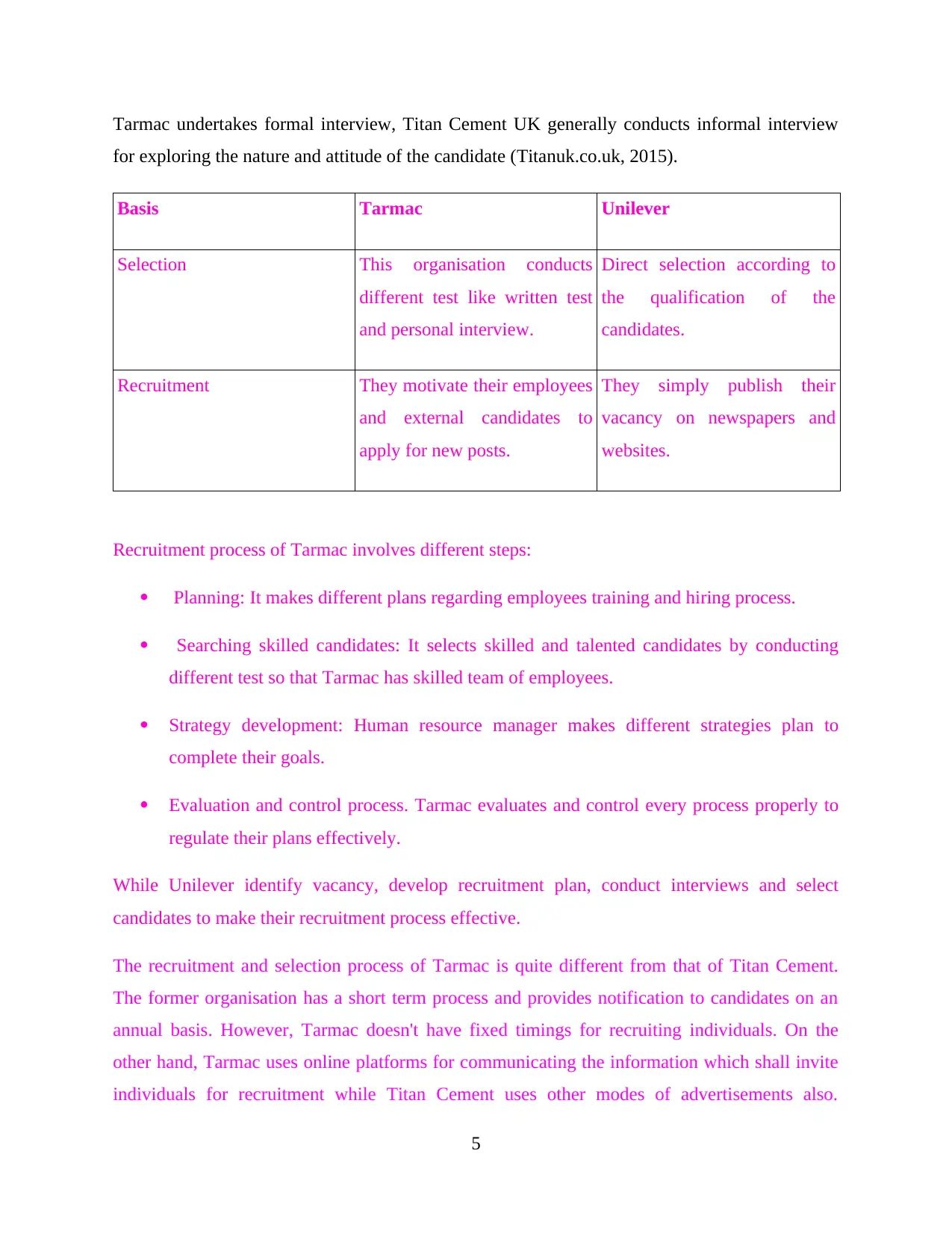
Tarmac undertakes formal interview, Titan Cement UK generally conducts informal interview
for exploring the nature and attitude of the candidate (Titanuk.co.uk, 2015).
Basis Tarmac Unilever
Selection This organisation conducts
different test like written test
and personal interview.
Direct selection according to
the qualification of the
candidates.
Recruitment They motivate their employees
and external candidates to
apply for new posts.
They simply publish their
vacancy on newspapers and
websites.
Recruitment process of Tarmac involves different steps:
Planning: It makes different plans regarding employees training and hiring process.
Searching skilled candidates: It selects skilled and talented candidates by conducting
different test so that Tarmac has skilled team of employees.
Strategy development: Human resource manager makes different strategies plan to
complete their goals.
Evaluation and control process. Tarmac evaluates and control every process properly to
regulate their plans effectively.
While Unilever identify vacancy, develop recruitment plan, conduct interviews and select
candidates to make their recruitment process effective.
The recruitment and selection process of Tarmac is quite different from that of Titan Cement.
The former organisation has a short term process and provides notification to candidates on an
annual basis. However, Tarmac doesn't have fixed timings for recruiting individuals. On the
other hand, Tarmac uses online platforms for communicating the information which shall invite
individuals for recruitment while Titan Cement uses other modes of advertisements also.
5
for exploring the nature and attitude of the candidate (Titanuk.co.uk, 2015).
Basis Tarmac Unilever
Selection This organisation conducts
different test like written test
and personal interview.
Direct selection according to
the qualification of the
candidates.
Recruitment They motivate their employees
and external candidates to
apply for new posts.
They simply publish their
vacancy on newspapers and
websites.
Recruitment process of Tarmac involves different steps:
Planning: It makes different plans regarding employees training and hiring process.
Searching skilled candidates: It selects skilled and talented candidates by conducting
different test so that Tarmac has skilled team of employees.
Strategy development: Human resource manager makes different strategies plan to
complete their goals.
Evaluation and control process. Tarmac evaluates and control every process properly to
regulate their plans effectively.
While Unilever identify vacancy, develop recruitment plan, conduct interviews and select
candidates to make their recruitment process effective.
The recruitment and selection process of Tarmac is quite different from that of Titan Cement.
The former organisation has a short term process and provides notification to candidates on an
annual basis. However, Tarmac doesn't have fixed timings for recruiting individuals. On the
other hand, Tarmac uses online platforms for communicating the information which shall invite
individuals for recruitment while Titan Cement uses other modes of advertisements also.
5
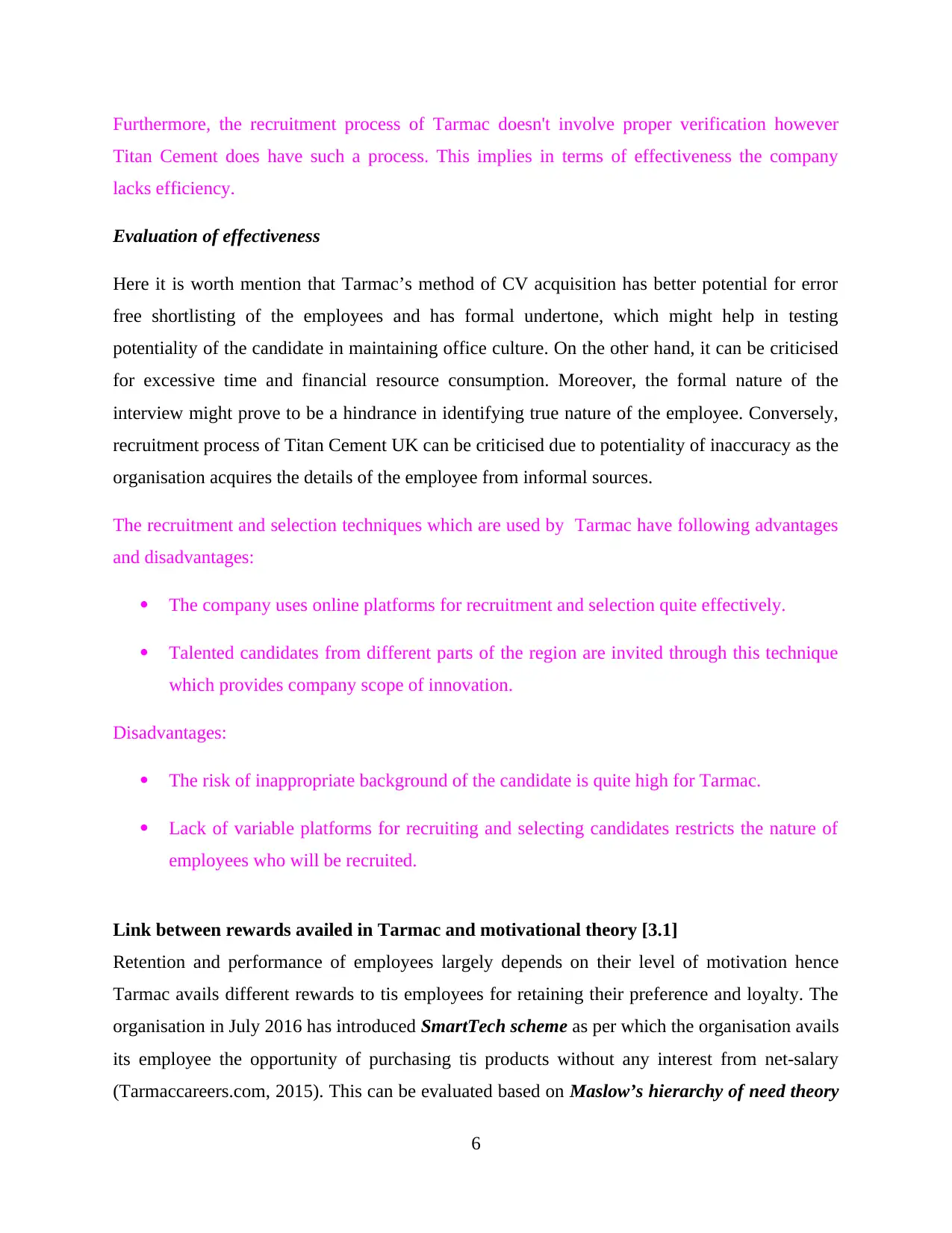
Furthermore, the recruitment process of Tarmac doesn't involve proper verification however
Titan Cement does have such a process. This implies in terms of effectiveness the company
lacks efficiency.
Evaluation of effectiveness
Here it is worth mention that Tarmac’s method of CV acquisition has better potential for error
free shortlisting of the employees and has formal undertone, which might help in testing
potentiality of the candidate in maintaining office culture. On the other hand, it can be criticised
for excessive time and financial resource consumption. Moreover, the formal nature of the
interview might prove to be a hindrance in identifying true nature of the employee. Conversely,
recruitment process of Titan Cement UK can be criticised due to potentiality of inaccuracy as the
organisation acquires the details of the employee from informal sources.
The recruitment and selection techniques which are used by Tarmac have following advantages
and disadvantages:
The company uses online platforms for recruitment and selection quite effectively.
Talented candidates from different parts of the region are invited through this technique
which provides company scope of innovation.
Disadvantages:
The risk of inappropriate background of the candidate is quite high for Tarmac.
Lack of variable platforms for recruiting and selecting candidates restricts the nature of
employees who will be recruited.
Link between rewards availed in Tarmac and motivational theory [3.1]
Retention and performance of employees largely depends on their level of motivation hence
Tarmac avails different rewards to tis employees for retaining their preference and loyalty. The
organisation in July 2016 has introduced SmartTech scheme as per which the organisation avails
its employee the opportunity of purchasing tis products without any interest from net-salary
(Tarmaccareers.com, 2015). This can be evaluated based on Maslow’s hierarchy of need theory
6
Titan Cement does have such a process. This implies in terms of effectiveness the company
lacks efficiency.
Evaluation of effectiveness
Here it is worth mention that Tarmac’s method of CV acquisition has better potential for error
free shortlisting of the employees and has formal undertone, which might help in testing
potentiality of the candidate in maintaining office culture. On the other hand, it can be criticised
for excessive time and financial resource consumption. Moreover, the formal nature of the
interview might prove to be a hindrance in identifying true nature of the employee. Conversely,
recruitment process of Titan Cement UK can be criticised due to potentiality of inaccuracy as the
organisation acquires the details of the employee from informal sources.
The recruitment and selection techniques which are used by Tarmac have following advantages
and disadvantages:
The company uses online platforms for recruitment and selection quite effectively.
Talented candidates from different parts of the region are invited through this technique
which provides company scope of innovation.
Disadvantages:
The risk of inappropriate background of the candidate is quite high for Tarmac.
Lack of variable platforms for recruiting and selecting candidates restricts the nature of
employees who will be recruited.
Link between rewards availed in Tarmac and motivational theory [3.1]
Retention and performance of employees largely depends on their level of motivation hence
Tarmac avails different rewards to tis employees for retaining their preference and loyalty. The
organisation in July 2016 has introduced SmartTech scheme as per which the organisation avails
its employee the opportunity of purchasing tis products without any interest from net-salary
(Tarmaccareers.com, 2015). This can be evaluated based on Maslow’s hierarchy of need theory
6
⊘ This is a preview!⊘
Do you want full access?
Subscribe today to unlock all pages.

Trusted by 1+ million students worldwide
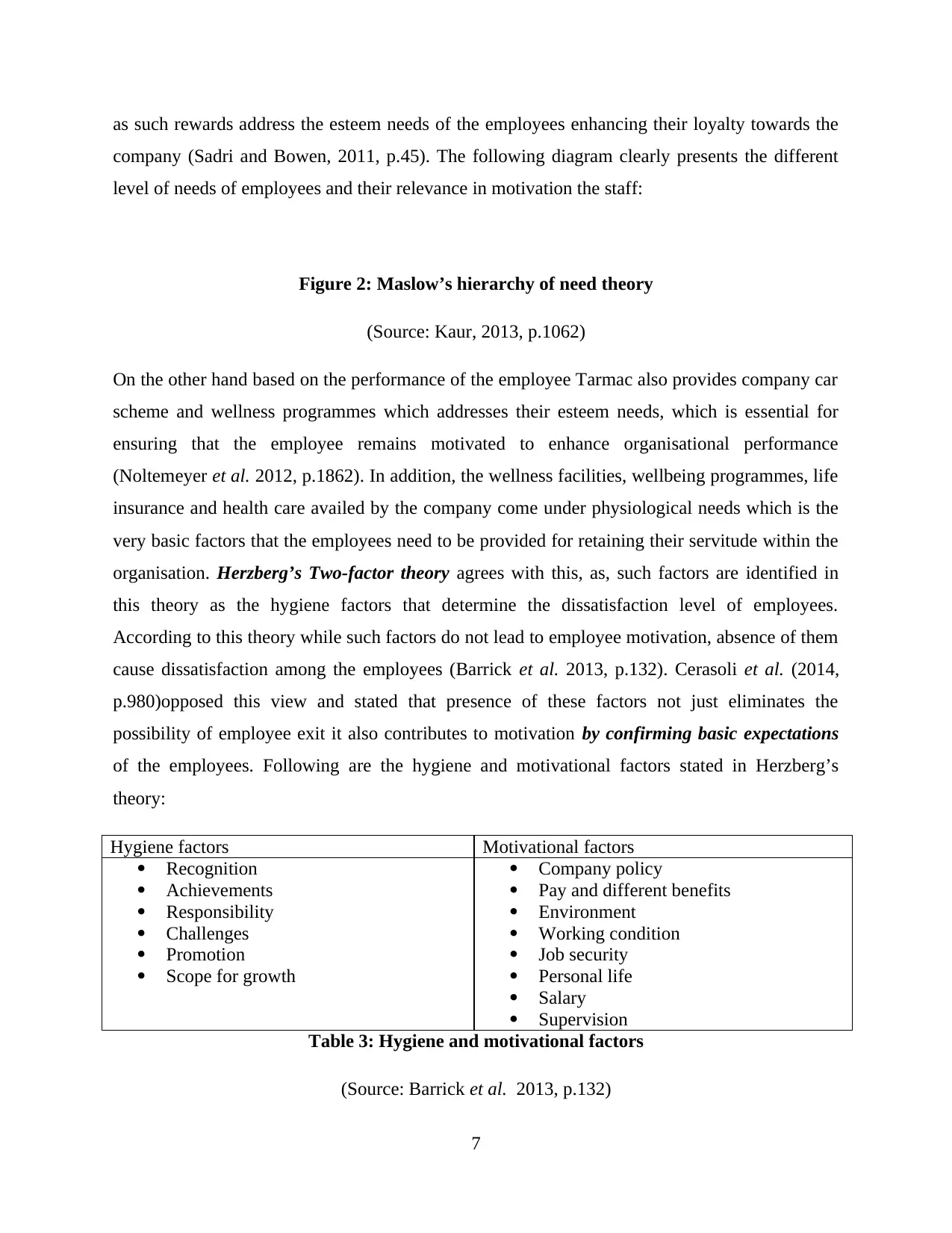
as such rewards address the esteem needs of the employees enhancing their loyalty towards the
company (Sadri and Bowen, 2011, p.45). The following diagram clearly presents the different
level of needs of employees and their relevance in motivation the staff:
Figure 2: Maslow’s hierarchy of need theory
(Source: Kaur, 2013, p.1062)
On the other hand based on the performance of the employee Tarmac also provides company car
scheme and wellness programmes which addresses their esteem needs, which is essential for
ensuring that the employee remains motivated to enhance organisational performance
(Noltemeyer et al. 2012, p.1862). In addition, the wellness facilities, wellbeing programmes, life
insurance and health care availed by the company come under physiological needs which is the
very basic factors that the employees need to be provided for retaining their servitude within the
organisation. Herzberg’s Two-factor theory agrees with this, as, such factors are identified in
this theory as the hygiene factors that determine the dissatisfaction level of employees.
According to this theory while such factors do not lead to employee motivation, absence of them
cause dissatisfaction among the employees (Barrick et al. 2013, p.132). Cerasoli et al. (2014,
p.980)opposed this view and stated that presence of these factors not just eliminates the
possibility of employee exit it also contributes to motivation by confirming basic expectations
of the employees. Following are the hygiene and motivational factors stated in Herzberg’s
theory:
Hygiene factors Motivational factors
Recognition
Achievements
Responsibility
Challenges
Promotion
Scope for growth
Company policy
Pay and different benefits
Environment
Working condition
Job security
Personal life
Salary
Supervision
Table 3: Hygiene and motivational factors
(Source: Barrick et al. 2013, p.132)
7
company (Sadri and Bowen, 2011, p.45). The following diagram clearly presents the different
level of needs of employees and their relevance in motivation the staff:
Figure 2: Maslow’s hierarchy of need theory
(Source: Kaur, 2013, p.1062)
On the other hand based on the performance of the employee Tarmac also provides company car
scheme and wellness programmes which addresses their esteem needs, which is essential for
ensuring that the employee remains motivated to enhance organisational performance
(Noltemeyer et al. 2012, p.1862). In addition, the wellness facilities, wellbeing programmes, life
insurance and health care availed by the company come under physiological needs which is the
very basic factors that the employees need to be provided for retaining their servitude within the
organisation. Herzberg’s Two-factor theory agrees with this, as, such factors are identified in
this theory as the hygiene factors that determine the dissatisfaction level of employees.
According to this theory while such factors do not lead to employee motivation, absence of them
cause dissatisfaction among the employees (Barrick et al. 2013, p.132). Cerasoli et al. (2014,
p.980)opposed this view and stated that presence of these factors not just eliminates the
possibility of employee exit it also contributes to motivation by confirming basic expectations
of the employees. Following are the hygiene and motivational factors stated in Herzberg’s
theory:
Hygiene factors Motivational factors
Recognition
Achievements
Responsibility
Challenges
Promotion
Scope for growth
Company policy
Pay and different benefits
Environment
Working condition
Job security
Personal life
Salary
Supervision
Table 3: Hygiene and motivational factors
(Source: Barrick et al. 2013, p.132)
7
Paraphrase This Document
Need a fresh take? Get an instant paraphrase of this document with our AI Paraphraser
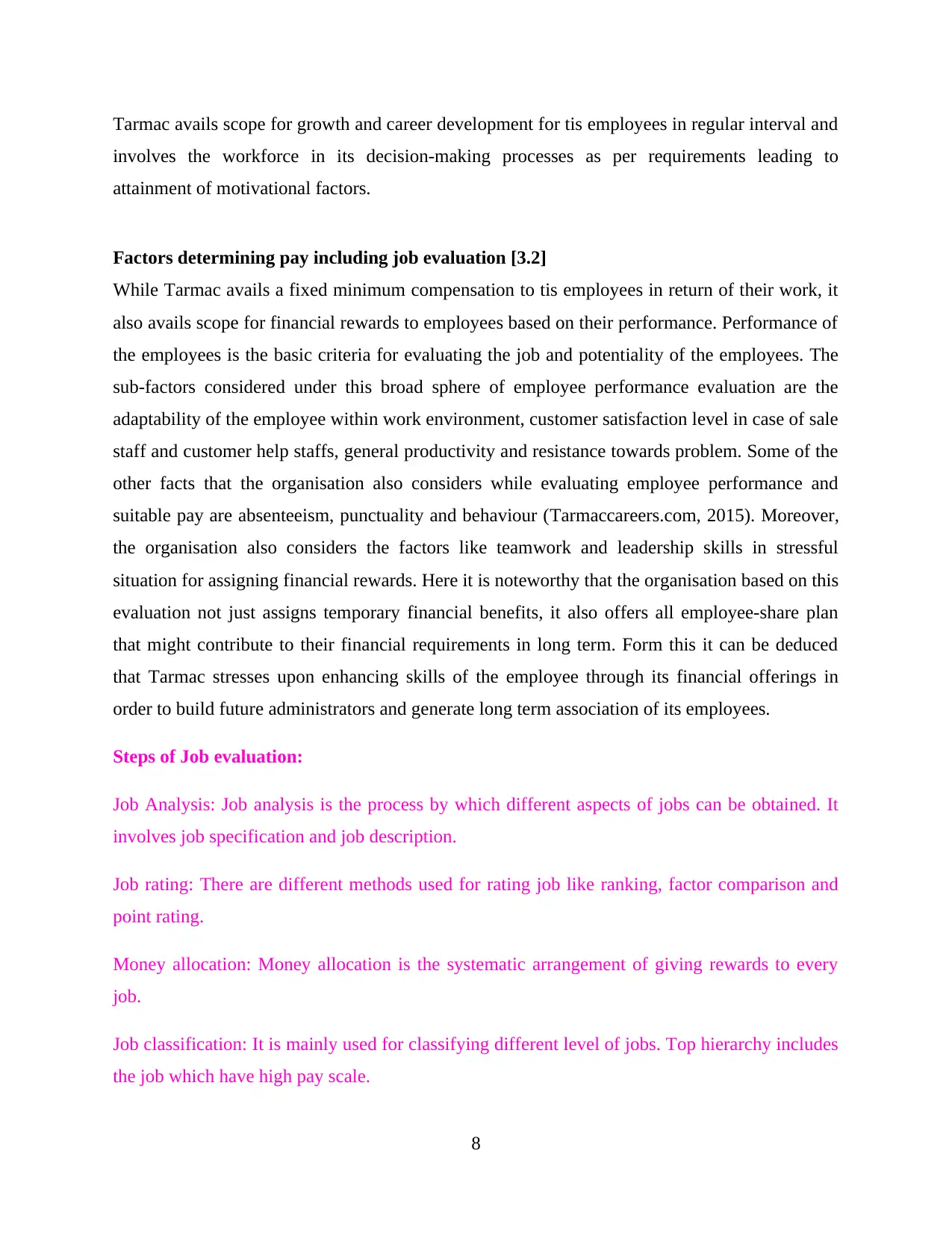
Tarmac avails scope for growth and career development for tis employees in regular interval and
involves the workforce in its decision-making processes as per requirements leading to
attainment of motivational factors.
Factors determining pay including job evaluation [3.2]
While Tarmac avails a fixed minimum compensation to tis employees in return of their work, it
also avails scope for financial rewards to employees based on their performance. Performance of
the employees is the basic criteria for evaluating the job and potentiality of the employees. The
sub-factors considered under this broad sphere of employee performance evaluation are the
adaptability of the employee within work environment, customer satisfaction level in case of sale
staff and customer help staffs, general productivity and resistance towards problem. Some of the
other facts that the organisation also considers while evaluating employee performance and
suitable pay are absenteeism, punctuality and behaviour (Tarmaccareers.com, 2015). Moreover,
the organisation also considers the factors like teamwork and leadership skills in stressful
situation for assigning financial rewards. Here it is noteworthy that the organisation based on this
evaluation not just assigns temporary financial benefits, it also offers all employee-share plan
that might contribute to their financial requirements in long term. Form this it can be deduced
that Tarmac stresses upon enhancing skills of the employee through its financial offerings in
order to build future administrators and generate long term association of its employees.
Steps of Job evaluation:
Job Analysis: Job analysis is the process by which different aspects of jobs can be obtained. It
involves job specification and job description.
Job rating: There are different methods used for rating job like ranking, factor comparison and
point rating.
Money allocation: Money allocation is the systematic arrangement of giving rewards to every
job.
Job classification: It is mainly used for classifying different level of jobs. Top hierarchy includes
the job which have high pay scale.
8
involves the workforce in its decision-making processes as per requirements leading to
attainment of motivational factors.
Factors determining pay including job evaluation [3.2]
While Tarmac avails a fixed minimum compensation to tis employees in return of their work, it
also avails scope for financial rewards to employees based on their performance. Performance of
the employees is the basic criteria for evaluating the job and potentiality of the employees. The
sub-factors considered under this broad sphere of employee performance evaluation are the
adaptability of the employee within work environment, customer satisfaction level in case of sale
staff and customer help staffs, general productivity and resistance towards problem. Some of the
other facts that the organisation also considers while evaluating employee performance and
suitable pay are absenteeism, punctuality and behaviour (Tarmaccareers.com, 2015). Moreover,
the organisation also considers the factors like teamwork and leadership skills in stressful
situation for assigning financial rewards. Here it is noteworthy that the organisation based on this
evaluation not just assigns temporary financial benefits, it also offers all employee-share plan
that might contribute to their financial requirements in long term. Form this it can be deduced
that Tarmac stresses upon enhancing skills of the employee through its financial offerings in
order to build future administrators and generate long term association of its employees.
Steps of Job evaluation:
Job Analysis: Job analysis is the process by which different aspects of jobs can be obtained. It
involves job specification and job description.
Job rating: There are different methods used for rating job like ranking, factor comparison and
point rating.
Money allocation: Money allocation is the systematic arrangement of giving rewards to every
job.
Job classification: It is mainly used for classifying different level of jobs. Top hierarchy includes
the job which have high pay scale.
8
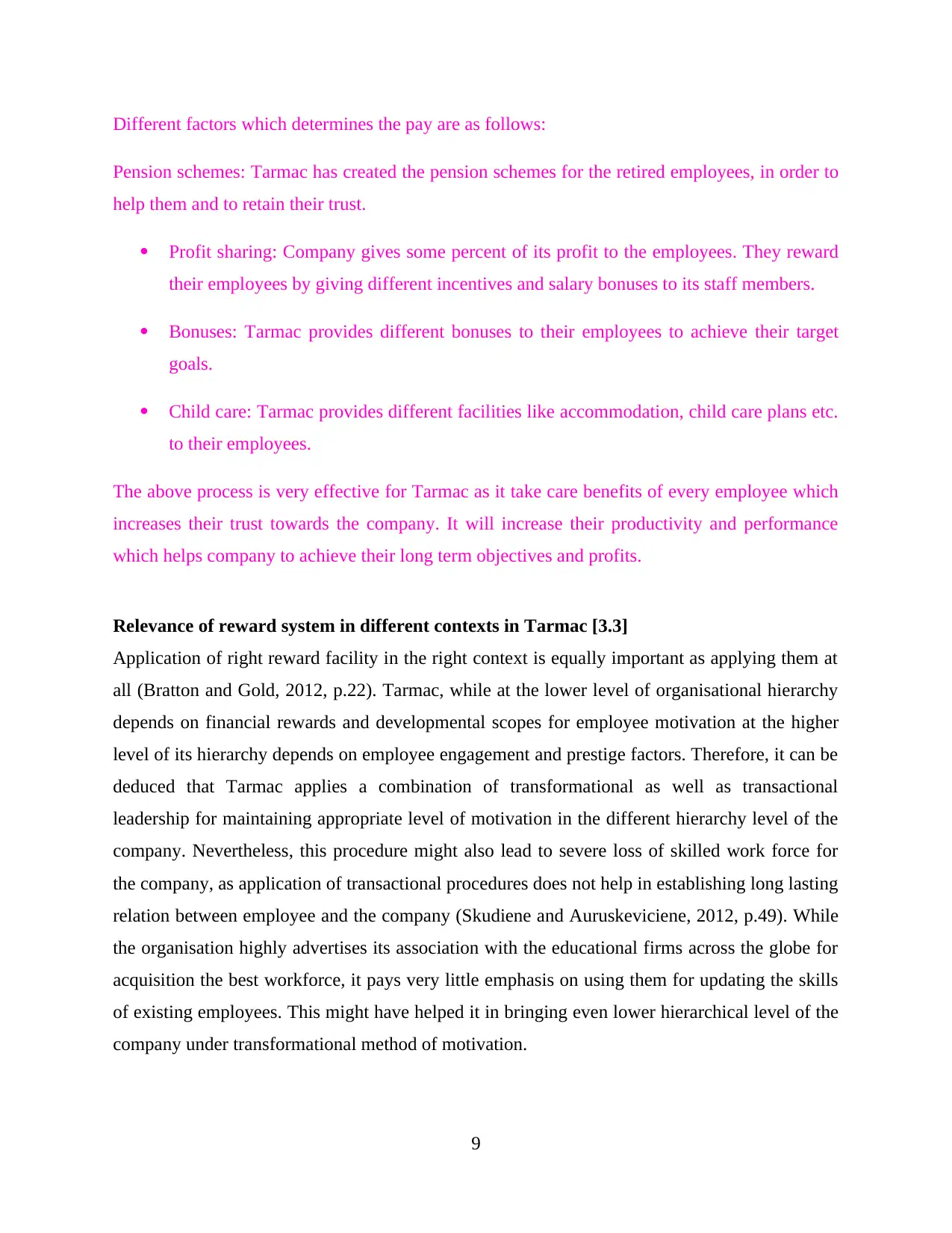
Different factors which determines the pay are as follows:
Pension schemes: Tarmac has created the pension schemes for the retired employees, in order to
help them and to retain their trust.
Profit sharing: Company gives some percent of its profit to the employees. They reward
their employees by giving different incentives and salary bonuses to its staff members.
Bonuses: Tarmac provides different bonuses to their employees to achieve their target
goals.
Child care: Tarmac provides different facilities like accommodation, child care plans etc.
to their employees.
The above process is very effective for Tarmac as it take care benefits of every employee which
increases their trust towards the company. It will increase their productivity and performance
which helps company to achieve their long term objectives and profits.
Relevance of reward system in different contexts in Tarmac [3.3]
Application of right reward facility in the right context is equally important as applying them at
all (Bratton and Gold, 2012, p.22). Tarmac, while at the lower level of organisational hierarchy
depends on financial rewards and developmental scopes for employee motivation at the higher
level of its hierarchy depends on employee engagement and prestige factors. Therefore, it can be
deduced that Tarmac applies a combination of transformational as well as transactional
leadership for maintaining appropriate level of motivation in the different hierarchy level of the
company. Nevertheless, this procedure might also lead to severe loss of skilled work force for
the company, as application of transactional procedures does not help in establishing long lasting
relation between employee and the company (Skudiene and Auruskeviciene, 2012, p.49). While
the organisation highly advertises its association with the educational firms across the globe for
acquisition the best workforce, it pays very little emphasis on using them for updating the skills
of existing employees. This might have helped it in bringing even lower hierarchical level of the
company under transformational method of motivation.
9
Pension schemes: Tarmac has created the pension schemes for the retired employees, in order to
help them and to retain their trust.
Profit sharing: Company gives some percent of its profit to the employees. They reward
their employees by giving different incentives and salary bonuses to its staff members.
Bonuses: Tarmac provides different bonuses to their employees to achieve their target
goals.
Child care: Tarmac provides different facilities like accommodation, child care plans etc.
to their employees.
The above process is very effective for Tarmac as it take care benefits of every employee which
increases their trust towards the company. It will increase their productivity and performance
which helps company to achieve their long term objectives and profits.
Relevance of reward system in different contexts in Tarmac [3.3]
Application of right reward facility in the right context is equally important as applying them at
all (Bratton and Gold, 2012, p.22). Tarmac, while at the lower level of organisational hierarchy
depends on financial rewards and developmental scopes for employee motivation at the higher
level of its hierarchy depends on employee engagement and prestige factors. Therefore, it can be
deduced that Tarmac applies a combination of transformational as well as transactional
leadership for maintaining appropriate level of motivation in the different hierarchy level of the
company. Nevertheless, this procedure might also lead to severe loss of skilled work force for
the company, as application of transactional procedures does not help in establishing long lasting
relation between employee and the company (Skudiene and Auruskeviciene, 2012, p.49). While
the organisation highly advertises its association with the educational firms across the globe for
acquisition the best workforce, it pays very little emphasis on using them for updating the skills
of existing employees. This might have helped it in bringing even lower hierarchical level of the
company under transformational method of motivation.
9
⊘ This is a preview!⊘
Do you want full access?
Subscribe today to unlock all pages.

Trusted by 1+ million students worldwide
1 out of 21
Related Documents
Your All-in-One AI-Powered Toolkit for Academic Success.
+13062052269
info@desklib.com
Available 24*7 on WhatsApp / Email
![[object Object]](/_next/static/media/star-bottom.7253800d.svg)
Unlock your academic potential
Copyright © 2020–2025 A2Z Services. All Rights Reserved. Developed and managed by ZUCOL.





